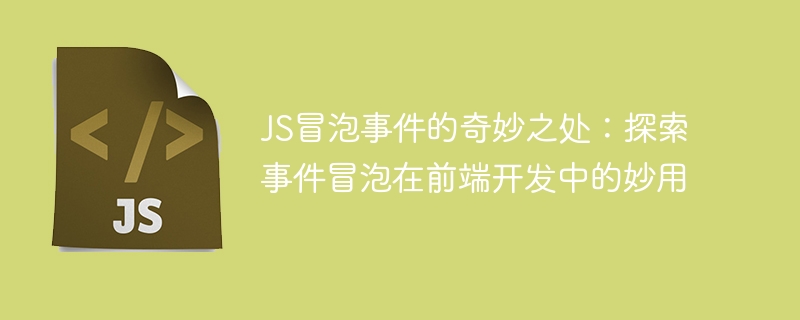Home >Web Front-end >JS Tutorial >Clever use of JS bubbling events in front-end development: In-depth exploration of the peculiarities of event bubbling
Clever use of JS bubbling events in front-end development: In-depth exploration of the peculiarities of event bubbling
- WBOYWBOYWBOYWBOYWBOYWBOYWBOYWBOYWBOYWBOYWBOYWBOYWBOriginal
- 2024-01-13 09:35:061390browse

The wonders of JS bubbling events: Exploring the wonderful use of event bubbling in front-end development
Introduction:
In front-end development, we often Encounter situations where you need to add event listeners for different elements. The JS bubbling event is a mechanism for handling event monitoring, which has great flexibility and convenience. This article will introduce the principle, application scenarios and specific code examples of event bubbling, hoping to help readers better understand and apply this feature.
1. The principle of event bubbling
Event bubbling means that when an element triggers an event, the event will be triggered in all ancestor elements of the element in turn, until the top-most element until. This mechanism allows developers to bind an event listener to an ancestor element to capture the same event for all its child elements.
Specifically, when an element triggers an event, such as a click event, the order of processing the event is as follows:
- The event is first processed on the element that triggered the event.
- After that, the event will be handled on the element's parent element, then on the parent element's parent element, and so on, until the top-most element.
- If a handler calls the stopPropagation() method of the event during the bubbling of the event, the bubbling of the event will be terminated, and subsequent ancestor elements will no longer handle the event.
2. Application scenarios of event bubbling
- Simplified event binding
Due to the event bubbling mechanism, we can bind an event listener to the parent element without having to bind on each child element. Doing so can greatly reduce the amount of code and improve the maintainability of the code. - Dynamicly adding elements
When we need to dynamically add elements to the DOM, if we do not use the event bubbling mechanism, we need to bind event listeners separately for each newly added element. Through event bubbling, we only need to bind event listeners to the parent element to capture the events of all newly added elements at the same time. - Event Agent
Event agent is an important application of the event bubbling mechanism, which can greatly simplify the management and processing of events. By adding event listeners to parent elements, we can dynamically execute corresponding processing codes based on the event types triggered by different child elements. This method is particularly suitable for event processing of a large number of similar elements, such as element click events in lists, form input events, etc.
3. Code Example
The following is a simple code example to demonstrate the wonderful use of event bubbling:
<!DOCTYPE html>
<html>
<head>
<title>事件冒泡示例</title>
</head>
<body>
<div id="parent">
<div id="child">
<button id="button">点击我</button>
</div>
</div>
<script>
// 为父元素添加事件监听
document.getElementById('parent').addEventListener('click', function(event) {
// 判断事件源是否为子元素
if (event.target.id === 'button') {
console.log('点击了按钮');
}
});
</script>
</body>
</html>In this example, we give the parent element the id " parent" element has a click event listener bound to it. When we click the button whose sub-element ID is "button", "button clicked" will be output on the console.
Through this example, we can see that through the event bubbling mechanism, we can only bind one event listener, capture events of multiple sub-elements at the same time, and process them accordingly as needed.
Conclusion:
The event bubbling mechanism brings great convenience and flexibility to front-end development. By making reasonable use of event bubbling, we can optimize the code structure, simplify the code logic, and improve the maintainability of the code. I hope the introduction and examples in this article can help readers better understand and apply the event bubbling mechanism.
The above is the detailed content of Clever use of JS bubbling events in front-end development: In-depth exploration of the peculiarities of event bubbling. For more information, please follow other related articles on the PHP Chinese website!

